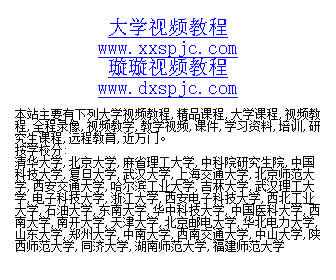![《标准模型动力学》(Dynamics of the Standard Model)英文影印版[DJVU]](http://pic.dxspjc.com/dx_pic/9120411/0530798.jpg)
书名: Dynamics of the Standard Model
中译名: 标准模型动力学
作者: John F. Donoghue, Eugene Golowich & Barry R. Holst
中国书号: 978-7-5062-9223-8
原版书号: 978-0-521-47652-2
原出版社: Cambridge University Press
中国出版社: 世界图书出版公司 北京公司
原版出版年代: 1992年
页码: 540
开本:16
扫描分辨率:600 dpi; 557 Scans
内容简介:
本书详细地阐述了粒子物理学中标准模型的基本理论尤其是动力学性质,重点强调该模型能够产生并可实际观测的物理现象,实现理论模型和真实世界的联系。书中绝大部分内容是介绍如何利用标准模型计算粒子的物理性质,涉及到很多实用的计算技巧,提高读者处理实际问题的能力。本书强调的是解决问题方法的严格性和可靠性,如基于对称和反常的辐射修正和非微扰技术。尤其值得一提的是,强相互作用和弱电相互作用没有被分开来讨论,而是交织在一起用统一的理论框架来处理。还包含了很多习题和图表等辅助学习资料,介绍了其它常用模型如夸克和Skyrme模型等。本书是“剑桥粒子物理、核物理和宇宙论系列丛书”中的第二本,可作为从事该领域工作的科研人员的参考资料和研究生粒子物理课程的教学用书。
本书特色:(1)全面讨论了在过去四十年中标准模型所取得的卓越成就。(2)详细讨论了标准模型的动力学性质,注重理论和实验的结合。(3)从教学角度介绍标准模型的基本理论,数学演绎过程详细。
读者对象:理论物理、粒子物理和高能物理等专业的高年级本科生、研究生和相关专业的科研人员。
目次:前言;(1)标准模型的引入;(2)标准模型中的相互作用;(3)对称和反常;(4)有效拉格朗日作用量简介;(5)轻子;(6)极低能量子电动力学 —介子和光子;(7)K介子和η子简介;(8)K介子和△S=1相互作用;(9)K介子混合和CP(宇称)不守恒;(10)展开;(11)唯象模型;(12)重子的性质;(13)强子谱;(14)重夸克的弱相互作用;(15)希格斯玻色子;(16)弱电规范玻色子;附录A:泛涵积分;附录B:若干场论方法;附录C:常用公式;参考文献;索引。
目录:
Preface
I Inputs to the Standard Model
I.1 Quarks and leptons
I.2 Chiral fermions
The massless limit
Parity, time reversal, and charge conjugation
I.3 Symmetries and near symmetries
Noether currents
Examples of Noether currents
Approximate symmetry
I.4 Gauge symmetry
Abelian case
Nonabelian case
Mixed case
I.5 On the fate of symmetries
Hidden symmetry
Spontaneous symmetry breaking in the sigma model
II Interactions of the Standard Model
II.1 Quantum Electrodynamics
U(1) gauge symmetry
QED to one loop
On-shell renormalization of the electric charge
Electric charge as a running coupling constant
II.2 Quantum Chromodynamics
SU(3) gauge symmetry
QCD to one loop
Asymptotic freedom and renormalization group
II.3 Electroweak interactions
Weak isospin and weak hypercharge assignments
SU(2) LxU(1)y gauge-invariant lagrangian
Spontaneous symmetry breaking
Electroweak currents
II.4 Fermion mixing
Diagonalization of mass matrices
Quark mixing
CP-violation and rephasing-invariants
III Symmetries and anomalies
III.1 Symmetries of the Standard Model
III.2 Path integrals and symmetries
The generating functional
Noether's theorem and path integrals
III.3 The U(1) axial anomaly
Diagrammatic analysis
Path integral analysis
III.4 Classical scale invariance and the trace anomaly
III.5 Chiral anomalies and vacuum structure
The θ-vacuum
The θ-term
Connection with chiral rotations
IV Introduction to effective lagrangians
IV.1 Nonlinear lagrangians and the sigma model
Representations of the sigma model
Representation independence
IV.2 Integrating out heavy fields
The decoupling theorem
Integrating out heavy fields at tree level
IV.3 The low energy expansion
Expansion in energy
Loops
Weinberg's power counting theorem
IV.4 Symmetry breaking
IV.5 PCAC
The soft-pion theorem
IV.6 Matrix elements of currents
Matrix elements and the effective action
IV.7 Heavy particles in effective lagrangians
IV.8 Effective lagrangians in QED
IV.9 Effective lagrangians as probes of new physics
V Leptons
V.1 The electron
Breit-Fermi interaction
QED corrections
The infrared problem
V.2 The muon
Muon decay at tree-level
Photon radiative corrections
V.3 The tan
Inclusive decays
Exclusive leptonic decays
Exclusive semileptonic decays
V.4 The neutrinos
Neutrino oscillations
Terrestial searches for neutrino mixing
Solar neutrinos
Dirac mass and Majorana mass
VI Very low energy QCD - pions and photons
VIA QCD at low energies
Vacuum expectation values and masses
Pion leptonic decay and Fπ
VI.2 Chiral perturbation theory to one loop
The order E4 lagrangian
The renormalization program
VI.3 Interactions of pious and photons
The pion form factor
Rare pion processes
VI.4 Pionopion scattering
VI.5 The axial anomaly and π0 →γγ
VI.6 The physics behind the QCD chiral lagrangian
VII Introducing kaons and etas
VII.1 Quark masses
VII.2 Higher order analysis of decay constants and masses
Ambiguities in mass parameters
Decay constants
Masses
VII.3 The Wess-Zumino-Witten anomaly action
VII.4 The η(960)
η0-η8 mixing
VIII Kaons and the AS = 1 interaction
VIII.1 Leptonic and semileptonic processes
Leptonic decay
Kaon beta decay and Vu8
The decay K→ππeve
VIII.2 The nonleptonic weak interaction
VIII.3 Short distance behavior
Short distance operator basis
Perturbative analysis
Renormalization group analysis
VIII.4 The ΔI = 1/2 rule
Phenomenology
Chiral lagrangian analysis
Vacuum saturation
VIII.5 Rare kaon decays
IX Kaon mixing and CP violation
IX.1 K0-K0 mixing
Mass matrix phenomenology
Box diagram contribution
IX.2 The phenomenology of lmon CP violation
IX.3 Kaon CP violation in the Standard Model
Analysis of
Penguin contribution to ε
Additional contributions to ε
IX.4 Electric dipole moments
IX.5 The strong CP problem
The parameter
Connections with the neutron electric dipole moment
X The Nc-1 expansion
X.1 The nature of the large Nc limit
X.2 Spectroscopy in the large Nc limit
X.3 Goldstone bosons and the axial anomaly
X.4 The OZI rule
X.5 Chiral lagrangians
X.6 Weak nonleptonic decays
XI Phenomenological models
XI.l Quantum numbers of QQ and Q3 states
Hadronic flavor-spin state vectors
Quark spatial wavefunctions
Interpolating fields
XI.2 Potential model
Basic ingredients
Mesons
Baryons
Color dependence of the interquark potential
XI.3 Bag model
Static cavity
Spherical cavity approximation
Gluons in a bag
The quark-gluon interaction
A sample fit
XI.4 Skyrme model
Sine-Gordon soliton
Chiral SU(2) soliton
The Skyrme soliton
Quantization and wavefunctions
XI.5 QCD sum rules
Correlators
Operator product expansion
Master equation
Examples
XII Baryon properties
XII.1 Matrix element computations
Flavor and spin matrix elements
Overlaps of spatial wavefunctions
Connection to momentum eigenstates
Calculations in the Skyrme model
XII.2 Electroweak matrix elements
Magnetic moments
Semileptonic matrix elements
XII.3 Symmetry properties and masses
Effective lagrangian for baryons
Baryon mass splittings and quark masses
Goldberger-Treiman relation
The nucleon sigma term
Strangeness in the nucleon
Quarks and their spins in baryons
XII.4 Nuclear weak processes
Measurement of Vud
The pseudoscalar axial form factor
XII.5 Hyperon semileptonic decay
XII.6 Nonleptonic decay
Phenomenology
Lowest-order chiral analysis
Quark model predictions
XIII Hadron spectroscopy
XIII.1 The charmonium and bottomonium systems
XIV Weak interactions of heavy quarks
XV The Higgs boson

